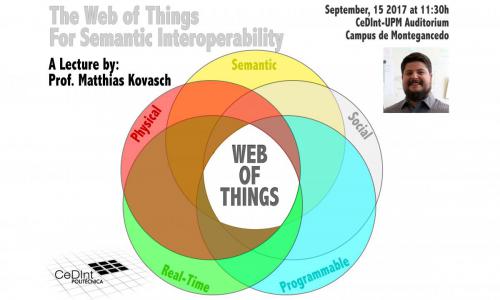The lecture "The Web of things For Semantic Interoperability" by Professor Matthias Kovatsch to take place at CeDInt

Next Friday September 15 at 11:30, the Lecture "The Web of things For Semantic Interoperability" by Prof. Matthias Kovatsch will take place at CeDInt.
After the conference (13:00h approx.) a refreshment will be served for attendees interested in further discussion and networking. If you are interested in attending the conference, please send a confirmation e-mail to: oalvarez(a)cedint.upm.es
Download official announcement.
Abstract:
The Web of Things seeks to counter the fragmentation of the IoT by using and extending existing, standardized Web technologies in order to enable easy integration across IoT platforms and application domains. For this, the W3C WoT Working Group is currently standardizing technological building blocks identified as being key to realizing the Web of Things: The WoT Thing Description provides a framework for semantic vocabularies to describe the data and interaction models exposed to applications, the choice of communications patterns provided by protocols, and the serialization formats used by individual IoT platforms. The WoT Scripting API provides a platform-independent application-facing API to implement IoT applications similar to Web applications running in a browser. The WoT Binding Templates provide the link to specific IoT platforms by defining a re-usable mapping between application-level interaction and low-level protocol operations. Overall, this is a step toward semantic interoperability in the IoT by building on well-known patterns from the Web and being descriptive rather than prescriptive.
Bio:
Matthias Kovatsch is a Senior Research Scientist at Siemens Corporate Technology and a Research Associate at ETH Zurich with a focus on Web technology for networked embedded systems. He is the creator of the Eclipse Californium (Cf) CoAP framework, Contiki’s Erbium (Er) REST Engine, and the Copper (Cu) Firefox add-on. With his interest in building a Web of Things around resource-constrained devices, large-scale distributed systems, and RESTful environments, he is active as an IoT Directorate member of the Internet Engineering Task Force (IETF) and a co-chair of the World Wide Web Consortium (W3C) Web of Things Interest Group as well as Working Group.
